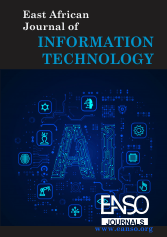Network Transformation and Productivity of Public Sector Institutions in Kenya
Abstract
Public institutions in Kenya undeniably create a conducive environment for economic development. However, public sector productivity in Kenya remains a concern, hindering socio-economic transformation, global competitiveness, and job creation. There has been a long-term decline in overall productivity from 0.45 in 2009 to 0.40 in 2022 with both labour productivity and total factor productivity falling over several decades. Further, the productivity of government MDAs ranges from 45% - 65% which implies the existence of wastages in the majority of the Ministries, Departments and Agencies (MDAs) assessed. It is against this backdrop that this study assesses the effect of network transformation on the national productivity of public sector institutions. The study population included 432 state departments and agencies that have mainstreamed national productivity as provided by the National Productivity and Competitiveness Centre (NPCC). The unit of analysis of the study was 432 MDAs that had mainstreamed national productivity while the unit of observations was Heads of departments of performance monitoring units in the MDAs. The formula adopted yielded a sample of 204 respondents from the target population. The study established that network transformation also had a significant positive impact on productivity. The findings showed that network transformation was significant, highlighting its role in improving communication, connectivity, and accessibility across public institutions. Enhanced network infrastructure facilitates seamless collaboration and improves response times in service delivery. The adoption of advanced network solutions, such as new architectures, network scalability and network security, was found to be essential for enabling digital transformation hence improving the productivity of public institutions. These solutions create scalable and efficient systems that support productivity
Downloads
References
Alliance for Affordable Internet. (2021, July 12). Kenya. Retrieved from https://a4ai.org/
Calista, D. J., & Melitski, J. (2007). E-government and e-governance: Converging constructs of public sector information and communications technologies. Public Administration Quarterly, 87-120.
Cette, G., Nevoux, S., & Py, L. (2022). The impact of ICTs and digitalization on productivity and labor share: evidence from French firms. Economics of innovation and new technology, 31(8), 669-692.
Chib, A., & Zhao, J. (2020). "Digital Infrastructure and Public Sector Effectiveness in Developing Countries." Information Technology for Development, 26(3), 421-439.
Criado, J. I., & Gil-Garcia, J. R. (2019). Creating public value through smart technologies and strategies: From digital services to artificial intelligence and beyond. International Journal of Public Sector Management, 32(5), 438-450.
Dyatlov, S. A., Didenko, N. I., Lobanov, O. S., & Kulik, S. V. (2019, July). Digital transformation and convergence effect as factors of achieving sustainable development. In IOP Conference Series: Earth and Environmental Science (Vol. 302, No. 1, p. 012102). IOP Publishing.
Esselaar, S., Stork, C., Ndiwalana, A., & Deen-Swarray, M. (2007). The e-Index: A Measure of the Information Society for Development. LINK Centre, University of the Witwatersrand.
Hai, T. N., Van, Q. N., & Thi Tuyet, M. N. (2021). Digital transformation: Opportunities and challenges for leaders in the emerging countries in response to COVID-19 pandemic. Emerging Science Journal, 5(1), 21-36.
Halachmi, A. (2004). E-government theory and practice: The evidence from Tennessee (USA). Frontiers of Public Administration, 24.
Hinings, B., Gegenhuber, T., & Greenwood, R. (2018). Digital innovation and transformation: An institutional perspective. Information and organization, 28(1), 52-61.
International Finance Corporation. (2022, February 22). Nigeria embracing digital transformation to unlock its economic potential. Retrieved from https://www.ifc.org/en/stories/2020/interview-with-eme-essien-lore-ifc-country-manager-in-nigeria
Jansen van Rensburg, S. J., Viviers, W., Parry, A., Strydom, P. D., Kühn, M. L., Orkoh, E., ... & Joubert, B. (2021). Africa's digital future: From theory to action (p. 420). AOSIS.
Johnson, M. P., & Rice, R. E. (2019). "Impact of Digital Connectivity on Public Sector Performance in the United States." Journal of Public Administration Research and Theory, 29(2), 293-308.
Kane, G. C., Palmer, D., & Phillips, A. N. (2019). Accelerating digital innovation inside and out. MIT Sloan Management Review.
Krawchenko, T. (2021, April). Public sector and productivity: Governing at the right scale. Background paper for the OECD‐EC high‐level Expert Workshop series “Productivity policy for places.
McKinsey Global Institute. (2020, January). Digital dividends: How digital technologies can boost productivity and growth. Retrieved from https://www.mckinsey.com/~/media/mckinsey/business%20functions/mckinsey%20digital/our%20insights/disruptive%20technologies/mgi_disruptive_technologies_full_report_may2013.ashx
Melo, B., Caldeira, J., Diniz, E., & Silva, W. (2020). Information and Communication Technology Adoption and Firm Performance: New Empirical Evidence from Developing Countries. Sustainability, 12(2), 577.
Müller, S. D., & Skau, C. (2018). "Digital Network Transformation and Government Efficiency: Evidence from Europe." Government Information Quarterly, 35(1), 89-102.
Ndubai, R. E. (2016). Performance contracting, measurement and public service delivery in Kenya (Doctoral dissertation, University of Nairobi).
Organisation for Economic Co-operation and Development. (2019). OECD Digital Economy Outlook 2019. Retrieved from https://www.oecd.org/digital/ieconomy/
Ozkan, S., & Kanat, I. E. (2011). e-Government adoption model based on theory of planned behavior: Empirical validation. Government Information Quarterly, 28(4), 503-513.
Pabst, A., & Westwood, A. (2021). The politics of productivity: Institutions, governance and policy (No. 015).
Panagiotopoulos, P., Klievink, B., & Cordella, A. (2019). Public value creation in digital government. Government Information Quarterly, 36(4), 101421.
Sainger, G. (2018). Leadership in digital age: A study on the role of leader in this era of digital transformation. International Journal on Leadership, 6(1), 1.
Union, A. (2020). The Digital Transformation Strategy for Africa (2020-30).
World Bank. (2017, May 18). Digital dividends dividend or debt? Retrieved from https://www.worldbank.org/en/publication/wdr2016
Copyright (c) 2025 Willian Too, Morrisson Mutuku

This work is licensed under a Creative Commons Attribution 4.0 International License.




























